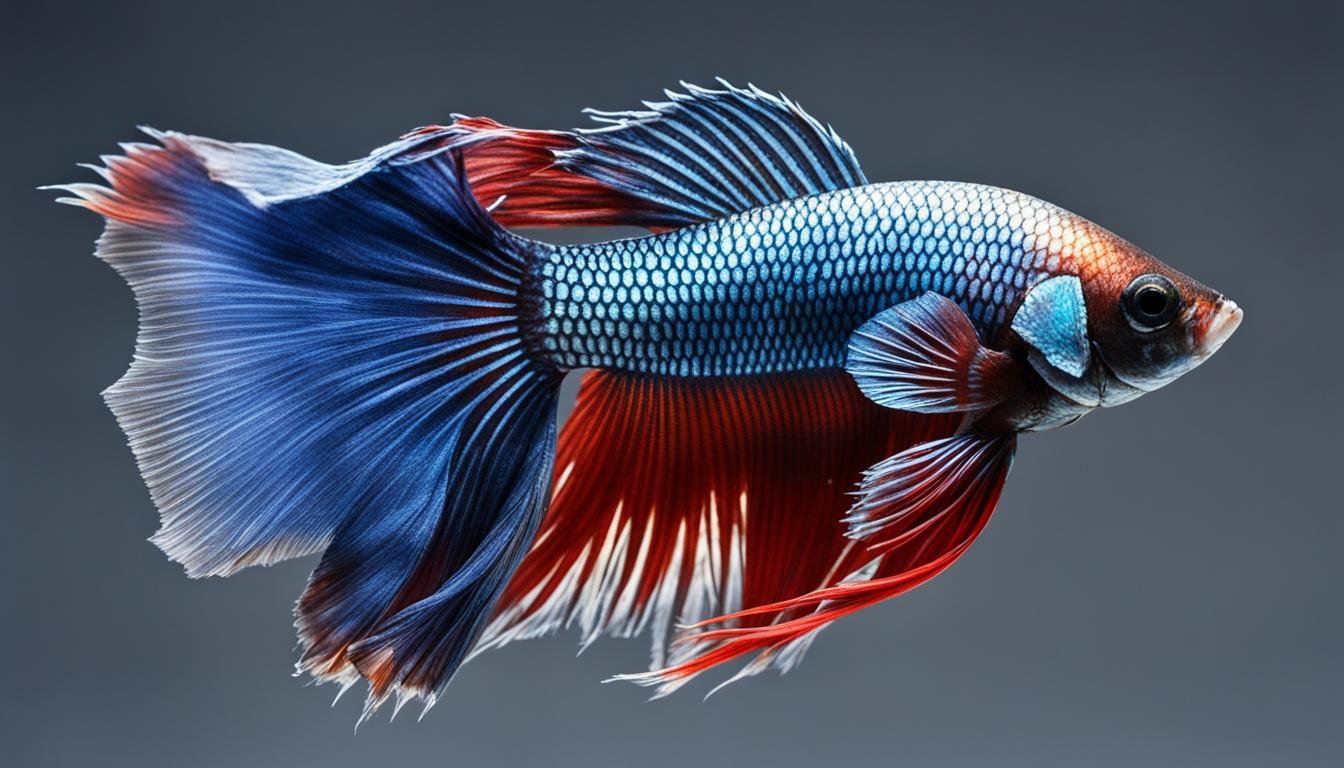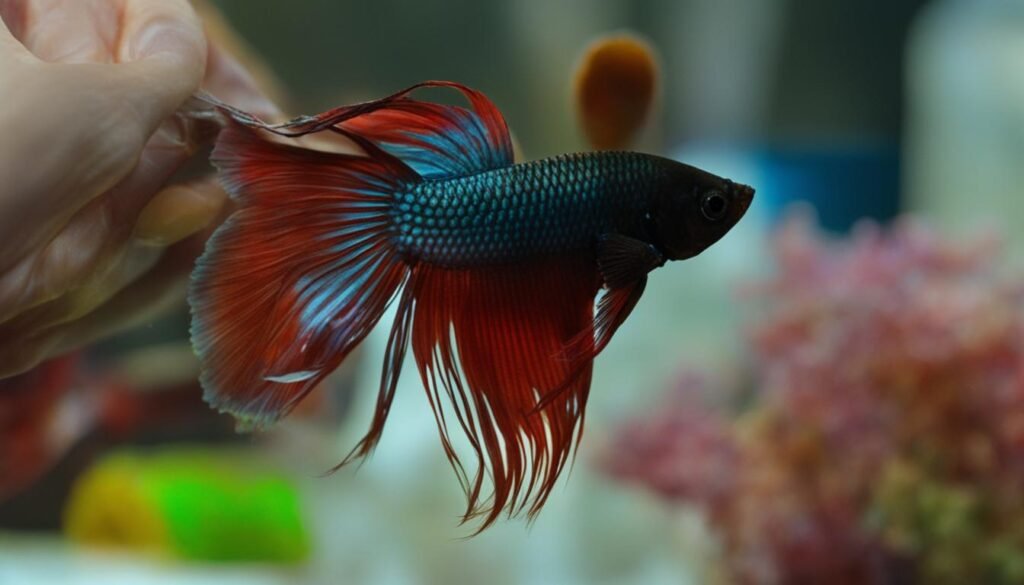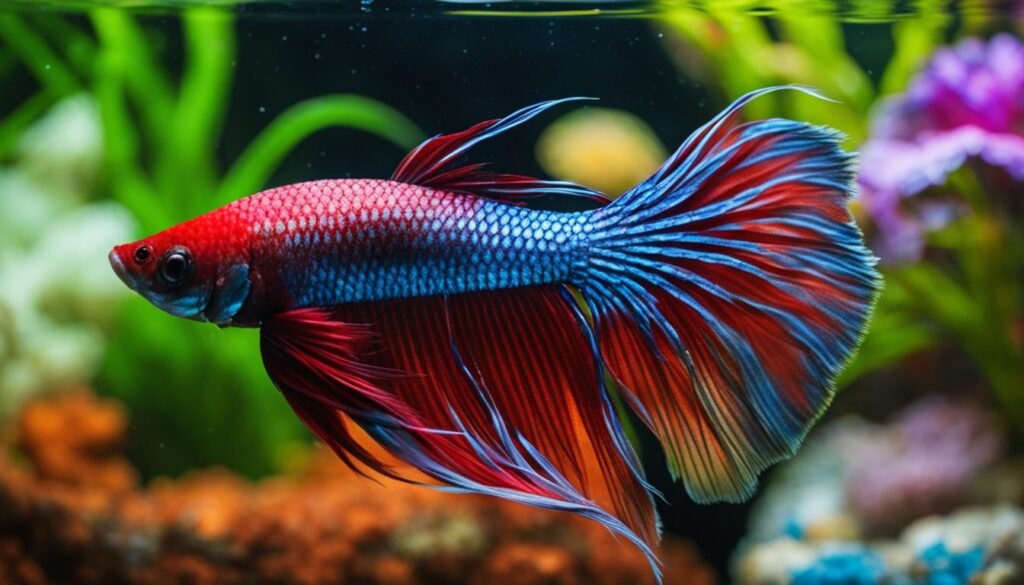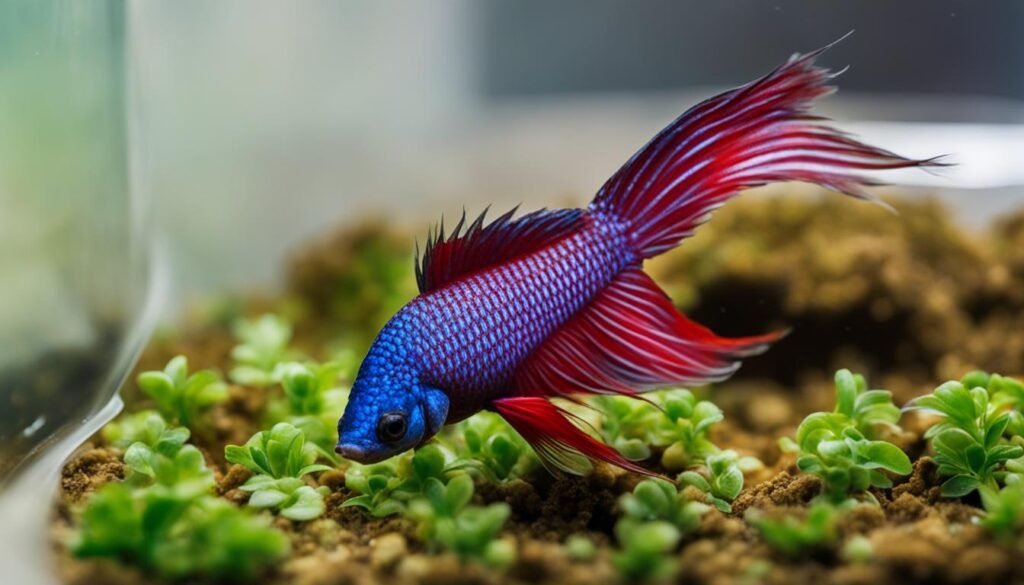Your cart is currently empty!

Understanding Why My Betta Fish’s Tail Is Ripping: Expert Advice
If you’ve noticed damage to your Betta fish’s tail, it’s important to understand the underlying causes and how to address them. Betta fish tail damage can occur due to various reasons, including fin loss or fin rot. In this article, we will explore the different causes of these conditions and provide expert advice on how to treat and prevent them, ensuring the health and well-being of your beloved Betta fish.
Key Takeaways:
- Fin loss and fin rot are common causes of Betta fish tail damage.
- Fin loss can be caused by factors such as the fish biting its own fins or sharp tank decorations.
- Fin rot is a condition that results from suboptimal tank conditions, leading to discoloration and deterioration of the fins.
- It is important to accurately diagnose the difference between fin loss and fin rot in order to provide the appropriate treatment.
- Proper care, such as removing sharp decorations, maintaining good water quality, and providing a stress-free environment, can help prevent and treat fin damage.
Causes of Fin Loss in Betta Fish
Fin loss in Betta fish can be attributed to various factors. Understanding these causes is crucial in order to take appropriate action and prevent further damage to your fish’s fins.
Betta Fish Tail Biting
One of the common causes of fin loss in Betta fish is tail biting. This behavior is typically a result of boredom or stress. When a Betta fish becomes anxious or lacks stimulation, they may resort to biting their own fins, leading to damage and tearing.
Sharp Tank Decorations
Another factor that can contribute to fin loss is the presence of sharp tank decorations. Fake plants, driftwood, rocks, or any other objects with rough edges can easily catch and tear the delicate fins of Betta fish. Ensuring that the tank is free from such sharp objects can help prevent fin damage.
Aggressive Tank Mates
Housing aggressive tank mates with your Betta fish can also lead to fin loss. Some fish species are known for their nipping or biting habits, and if they are not compatible with Betta fish, they may cause damage to their fins. It is important to research and choose tank mates that are peaceful and compatible with Betta fish to prevent fin-related issues.
Understanding Fin Rot in Betta Fish

Fin rot is a common condition that can affect Betta fish, causing discoloration, deterioration, and fraying of their fins. It is important to understand the causes of fin rot and how to prevent and treat it to ensure the health and well-being of your Betta fish.
One of the primary causes of fin rot is unsuitable tank conditions. Poor water quality, improper temperature, and high levels of ammonia or nitrate can stress the fish and make them more susceptible to infections. It’s essential to regularly monitor the water conditions in your Betta’s tank and take appropriate steps to maintain optimal conditions.
In addition to poor tank conditions, other factors can contribute to the development of fin rot. Stress, trauma, and injuries to the fins can create an entry point for bacteria and fungus, leading to an infection. It’s important to provide a stress-free environment for your Betta fish and avoid sharp tank decorations or aggressive tank mates that may cause damage to their fins.
To prevent and treat fin rot, it is crucial to address the underlying causes and take appropriate action. This may involve conducting regular water changes, maintaining proper filtration, and adjusting the water temperature to the recommended range. In more severe cases, you may need to use antibacterial or antifungal medications, as advised by a veterinarian or pet store professional.
Summary:
- Fin rot is a condition that causes discoloration and deterioration of Betta fish fins.
- Unsuitable tank conditions, such as poor water quality and improper temperature, are common causes of fin rot.
- Stress, trauma, and injuries to the fins can make Betta fish more susceptible to fin rot.
- Preventing and treating fin rot involves maintaining optimal tank conditions, providing a stress-free environment, and using appropriate medications if necessary.
Distinguishing Between Fin Loss and Fin Rot in Betta Fish
When it comes to Betta fish health, understanding the difference between fin loss and fin rot is crucial. While both conditions can affect the fins of your Betta, the causes and symptoms vary. Being able to recognize the signs and symptoms of each condition will help you accurately diagnose and address the issue, ensuring the proper treatment for your fish’s well-being.
Signs and Symptoms of Fin Loss
Fin loss in Betta fish is characterized by physical tearing of the fins, resulting in a ripped appearance. Some common signs of fin loss include:
- Torn or frayed fins
- Uneven or jagged edges on the fins
- Visible bite marks on the fins
Signs and Symptoms of Fin Rot
Fin rot in Betta fish, on the other hand, is characterized by discoloration on the fins, which may progress to deterioration and fraying. Here are some common signs of fin rot to look out for:
- Discolored or darkened areas on the fins
- Fins that appear ragged or deteriorated
- Redness or inflammation along the edges of the fins
By paying attention to these signs and symptoms, you can determine whether your Betta fish is experiencing fin loss or fin rot. This knowledge will help you take the appropriate steps to address and treat the condition, ensuring the best possible care for your beloved fish.
Treating Fin Loss in Betta Fish

If your Betta fish is experiencing fin loss, there are several steps you can take to help facilitate fin regrowth and promote their overall health. Here are some effective methods for treating fin loss in Betta fish:
- Remove sharp tank decorations: If sharp tank decorations are causing the damage to your Betta fish’s fins, it is important to remove them to prevent further injury. Opt for smooth and safe decorations instead.
- Maintain a clean and well-maintained tank: Providing a clean and well-maintained tank is crucial for the healing process. Regular water changes and proper filtration will help maintain optimal water conditions and prevent infection.
- Ensure suitable living conditions: Betta fish thrive in a stress-free environment. Make sure the water temperature is within the recommended range and provide a balanced diet to support their overall health and fin regrowth.
It is important to note that minor fin loss may heal naturally over time without intervention. However, if the fin loss persists or worsens, it is advisable to consult with a veterinarian or pet store professional for further guidance and potential treatments.
Treating Fin Rot in Betta Fish

When it comes to treating fin rot in Betta fish, there are several steps you can take to help your fish heal and prevent further damage. The first and most important step is to address and correct the underlying causes of fin rot, such as poor water quality and unsuitable tank conditions. This may involve adjusting the water temperature, conducting regular water changes, and maintaining proper filtration to keep ammonia and nitrate levels under control.
In addition to improving the tank conditions, using antibacterial or antifungal medications can be beneficial in eliminating the infection and promoting fin healing. It is recommended to consult with a veterinarian or pet store professional to determine the most suitable medications for your Betta fish. Follow the instructions provided carefully and monitor your fish’s progress closely.
While treating fin rot, it is essential to maintain a stress-free environment for your Betta fish. Stress can weaken their immune system, making it harder for them to heal. Ensure your fish has a comfortable and spacious habitat, with suitable tankmates and minimal disruptions. Providing a balanced diet with high-quality food can also support their overall health and aid in the healing process.
Treatment Steps for Fin Rot in Betta Fish:
- Assess and improve tank conditions, including water temperature and quality.
- Consult with a veterinarian or pet store professional for appropriate medications.
- Follow medication instructions carefully and monitor your fish’s progress.
- Create a stress-free environment with suitable tankmates and a balanced diet.
By taking these steps and providing proper care, you can help your Betta fish on their journey to recovery from fin rot. Remember, fin rot can be a serious condition, and if left untreated, it may lead to more severe health issues. If you notice persistent or worsening symptoms, it is important to seek professional advice to ensure the best possible care for your fish.
Betta Fish Tail Care: Preventing Fin Loss and Fin Rot

Proper care and maintenance are crucial for ensuring the health and well-being of your Betta fish, and this includes taking measures to prevent fin loss and fin rot. By following these tips and guidelines, you can help keep your Betta fish’s tail healthy and vibrant:
1. Create an optimal tank environment:
- Ensure the tank is of sufficient size for your Betta fish, with appropriate water volume.
- Avoid overcrowding the tank to reduce stress and prevent fin nipping.
- Choose tankmates carefully, opting for peaceful species that won’t harass or damage your Betta’s fins.
- Remove any sharp or abrasive decorations that may cause injury to your Betta fish’s delicate fins.
2. Maintain good water quality:
- Regularly test the water parameters such as pH, ammonia, nitrite, and nitrate levels.
- Perform routine water changes to keep the water clean and free from harmful toxins.
- Ensure proper filtration to remove impurities and maintain a healthy tank environment.
3. Provide a balanced diet:
- Feed your Betta fish a nutritionally complete diet that includes high-quality pellets or flakes.
- Offer occasional treats such as frozen or live foods for added variety and enrichment.
- Avoid overfeeding, as excess food can lead to water pollution and health issues.
By implementing these preventative measures and practicing good Betta fish tail care, you can help minimize the risk of fin loss and fin rot in your beloved fish. Remember to monitor your Betta’s tail regularly for any signs of damage or discoloration, and seek professional advice if necessary.
The Healing Process for Betta Fish’s Torn Fins

Torn fins in Betta fish have the remarkable ability to heal over time. The timeline for healing can vary depending on the severity of the damage and the overall health of the fish. With proper care and attention, torn fins can begin to heal within a week to several months.
To facilitate the healing process, it’s important to address the underlying causes of the fin damage. This includes removing any sharp tank decorations that may be causing further harm. Providing a clean and well-maintained tank with suitable living conditions is essential. Maintaining proper water temperature, ensuring a balanced diet, and creating a stress-free environment will contribute to the healing process for your Betta fish’s fins.
Facilitating Fin Healing in Betta Fish
- Remove sharp tank decorations that may be causing further damage to the fins.
- Regularly monitor and maintain optimal tank conditions, including proper water temperature.
- Provide a balanced diet rich in nutrients to support fin regeneration.
- Ensure a stress-free environment by avoiding overcrowding in the tank and providing suitable tankmates.
- Consider using aquarium salt in appropriate proportions to promote healing.
- Consult with a veterinarian or pet store professional for guidance and support.
By closely monitoring the healing process and making necessary adjustments to the treatment plan, you can help ensure a successful recovery for your Betta fish’s torn fins.
Treatment Methods for Betta Fish’s Torn Fins

If your Betta fish has torn fins, there are several treatment methods that can help promote healing and restore their fin health. These methods include:
Adjusting Water Temperature
One way to aid in the healing process is by adjusting the water temperature in your Betta fish’s tank. Keeping the water temperature within the optimal range for Betta fish, which is around 78-80°F (25-27°C), can help create a comfortable and stress-free environment for your fish.
Adding Salt to the Water
Another method is to add aquarium salt to the water in appropriate proportions. Aquarium salt can help promote healing and prevent infection in torn fins. It is important to follow the recommended dosage provided by a veterinarian or pet store professional when adding salt to the tank.
Treating with Medication
In more advanced cases of fin damage, using medications can be beneficial. There are antibacterial and antifungal medications available that can help eliminate infection and promote fin healing. It is essential to follow the directions provided by a veterinarian or pet store professional when using these medications to ensure their safe and effective use.
Remember, the choice of treatment method will depend on the severity of the fin damage and the specific needs of your Betta fish. Consulting with a veterinarian or pet store professional is always recommended to determine the best course of action for your fish’s torn fins.
Maintaining Good Tank Conditions for Betta Fish

Creating and maintaining optimal tank conditions is crucial for the health and well-being of your Betta fish. By following proper tank maintenance practices, you can minimize the risk of fin damage and other health issues. Here are some essential steps to ensure your Betta fish’s tank remains in top shape:
- Regular Water Monitoring: It’s important to regularly test the water parameters in your Betta fish’s tank. Regularly check the pH level, ammonia, nitrite, and nitrate levels to maintain a healthy environment. You can use test kits available at pet stores to monitor these levels.
- Performing Regular Water Changes: Regular water changes are vital for maintaining optimal water quality. Aim to change 25-50% of the tank water every week or as needed. This helps remove any accumulated toxins and keeps the water clean and fresh for your Betta fish.
- Maintaining Proper Water Temperature: Betta fish are tropical fish that thrive in warm water. The ideal water temperature for Betta fish is between 78-82°F (25-28°C). Use a reliable aquarium heater and thermometer to ensure the water temperature remains constant.
- Cleaning Tank Accessories: Clean the tank accessories, such as decorations, filters, and air stones, regularly to prevent the build-up of algae and debris. Use a soft brush or sponge to gently scrub away any dirt, and rinse thoroughly before placing them back into the tank.
By following these maintenance practices, you can provide a clean and healthy environment for your Betta fish, reducing the risk of fin damage and promoting their overall well-being.
Conclusion
In conclusion, taking care of your Betta fish’s tail is essential for their health and well-being. Understanding the causes of fin loss and fin rot will help you provide the appropriate care and treatment for your fish. By addressing and correcting the underlying factors such as stress, poor water quality, and unsuitable tank conditions, you can promote the natural healing of torn fins over time.
Regular monitoring and maintenance of your Betta fish’s tank conditions is key to preventing fin damage and other health issues. This includes maintaining optimal water temperature, conducting regular water testing, and performing necessary water changes. Avoiding sharp tank decorations and providing a stress-free environment will also help prevent fin loss and fin rot.
If your Betta fish’s fins are severely damaged, medications and other treatment methods may be necessary. Always consult with a veterinarian or pet store professional for guidance and support in caring for your Betta fish. Remember, providing proper Betta fish tail care will contribute to their overall health and happiness.
FAQ
What causes fin loss in Betta fish?
Fin loss in Betta fish can be caused by various factors, including the fish biting their own fins due to boredom or stress, sharp tank decorations, and housing aggressive tank mates.
What is fin rot in Betta fish?
Fin rot is a condition in Betta fish that results from suboptimal tank conditions and can manifest as discoloration on the fins. It is important to monitor water quality and take steps to prevent fin rot.
How can I distinguish between fin loss and fin rot in my Betta fish?
Fin loss is characterized by physical tearing of the fins, while fin rot is characterized by discoloration on the fins that may progress to deterioration. Recognizing the signs and symptoms will help you accurately diagnose and address the issue.
What should I do if my Betta fish has minor fin loss?
In cases of minor fin loss, you may not need to take any action as the fins can heal naturally over time. However, removing sharp tank decorations and providing a clean and well-maintained tank can promote fin regrowth.
How do I treat fin rot in my Betta fish?
The treatment of fin rot often involves addressing and correcting underlying causes, such as poor water quality. This may include adjusting water temperature, conducting regular water changes, and using medications recommended by a professional.
How can I prevent fin loss and fin rot in my Betta fish?
Preventing fin loss and fin rot involves ensuring optimal tank conditions, such as maintaining good water quality, avoiding overcrowding, and providing suitable tankmates. Feeding a balanced diet and following proper feeding practices also contribute to overall health.
How long does it take for torn fins to heal in Betta fish?
The healing time for torn fins can vary depending on the severity of the damage and the overall health of the fish. With appropriate treatment and attention to the underlying causes, torn fins can begin to heal within a week to several months.
What treatment methods can I use to promote the healing of torn fins in my Betta fish?
Treatment methods for torn fins can include adjusting water temperature, adding aquarium salt to the water, and using medications for more advanced cases of fin rot. The choice of treatment will depend on the severity of the damage and the specific needs of the fish.
How do I maintain good tank conditions for my Betta fish?
Maintaining good tank conditions involves regular monitoring of water parameters, proper water changes, cleaning tank accessories, and maintaining the correct water temperature. These practices create an optimal environment for your Betta fish and minimize the risk of fin damage and other health issues.
Do I need to consult a professional for Betta fish tail care?
It is always recommended to consult with a veterinarian or pet store professional for guidance and support in caring for your Betta fish. They can provide expert advice tailored to your specific situation and help ensure the best care for your fish.
Leave a Reply